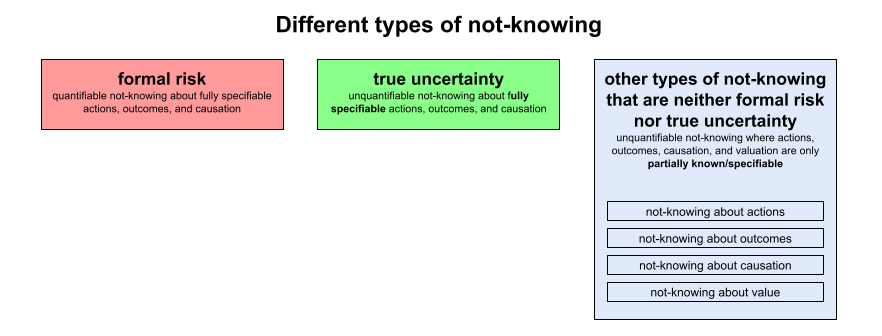The fog of time
18/9/2023 ☼ not-knowing ☼ risk ☼ uncertainty ☼ strategy ☼ time
tl;dr: This is the reading for the 9th episode in my monthly discussion series on not-knowing. Futurity affects not-knowing via five futurity levers that can be affected by their respective influencing actions (in bold):
- Discoveries of new actions and new outcomes; exploration.
- Discoveries of new causal pathways; experimentation.
- Changes in the scope of the possible; imagination.
- Changes in the relative scarcity of resources; reallocation.
- Changes in norms about how valuable things are; philosophy.
I’ve argued previously that risk is only one among many types of not-knowing, and that mixing up different types of not-knowing is Very Bad but unfortunately very common. Thinking clearly is the first step to figuring out how to better relate to not-knowing.
Different types of non-risk not-knowing show up in relation to actions we could take and outcomes we could achieve, the causal connection between actions and outcomes, and the value of outcomes.
 Risk, true (Knightian) uncertainty, and other types of not-knowing.
Risk, true (Knightian) uncertainty, and other types of not-knowing.
Futurity (things that may happen in the future) potentially affects each of these different types of non-risk not-knowing. We could think of each of these things as sources of change in the amount and type of not-knowing — levers for modifying what and how much not-knowing we face. These levers operate at different levels of analysis, from individuals to small groups, to organizations, to whole societies.
There are at least 5 different categories of futurity levers, each affecting different types of not-knowing. These levers are opportunities for intentional action with particular outcomes in mind these futurity levers are an opportunity for strategy. While each lever can be pulled through different types of actions, each is most closely connected with one particular type of influencing action.
The connections between influencing actions, futurity levers, and types of not-knowing are shown in the diagram below:
 Influencing actions, futurity levers, and types of not-knowing.
Influencing actions, futurity levers, and types of not-knowing.
1: Discovery of new actions/outcomes.
“Actions” are things people can do, and “outcomes” result from actions people take. Discovery can be genuinely new (like the creation of a new material) or be new in context. Examples of discovering new actions and outcomes range from a company taking the action of selling subscription-based software access vs selling the software outright (a new action in context of software) to a graduating high-school student discovering a new outcome in the form of a fellowship program that would fund not going to college for a few years. Affects: Not-knowing about actions and about outcomes. Influencing action: Exploration increases the likelihood of both discovering genuinely new things and discovering things that are new in context.
2: Discovery of new causal pathways.
“Causal pathways” describe how actions taken are connected to outcomes that result. Discovering a new causal pathway can result from testing actions to see what outcomes result, or researching the causes of a particular outcome. Examples include the discovery that the action of spraying DDT not only creates the desired outcome of suppressing insect disease vectors but also the undesired outcomes of reducing bird populations and becoming more concentrated up the food chain, and the discovery that natural rubber became more durable when heated with sulfur. Affects: Not-knowing about causation. Influencing action: Experimentation, which is a specific form of exploration designed to investigate hypotheses about the connection between specific actions and specific intended outcomes.
3: Change in the scope of the possible.
The “scope of the possible” refers to our beliefs about the limits imposed by convention, tradition, or physical law. When these limits are modified or suspended, what is possible (actions, outcomes, or causation) changes. Examples include a country tipping toward a revolution against its ruling class after observing a successful analogous revolution in another country, or a student from a poor family being motivated to apply to college after meeting first-generation college students who received financial aid.
Affects: Not-knowing about outcomes, about causation, and about value. Influencing action: Imagination, especially when it is constrained to thinking about plausible futures anchored in the present but with the selective suspension of current conditions/assumptions (= imaginary ethnography).
4: Change in the relative scarcity of resources.
The value we attach to any outcome is driven by the resources needed to take the actions that achieve that outcome. When the scarcity of those resources changes, the value of their associated outcomes changes too. Examples include the sudden change in the prevalence of legal slavery after the Civil War in the US changing the viability of agricultural business models in former slave states, and increased awareness of water scarcity changing the marketing value of reduced-water textile manufacturing processes. Affects: Not-knowing about value. Influencing action: Reallocation of resources to different actions and outcomes.
5: Change in norms about how valuable things are.
Subjective norms about value change because of social movements. These changes in norms in turn change how much particular outcomes are valued relative to other outcomes. Examples include changes in what is considered fashionable (e.g., the transition from figurative to abstract art among major art collectors, or the transition from skinny jeans to anti-fit jeans among fashion victims) and changes in what is considered morally acceptable (e.g., the turn against university endowment investments in armaments, palm oil, or extractive industries). Affects: Not-knowing about value. Influencing action: Philosophy, which is both a discipline and an activity, one branch of which is the consideration of value.